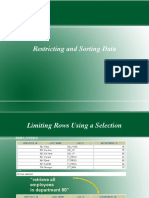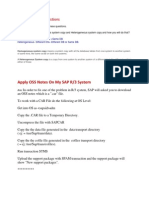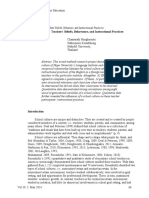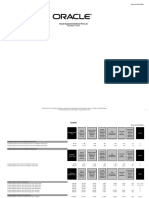SQL Cheat Sheet PDF
Uploaded by
narenkarthickgururajuSQL Cheat Sheet PDF
Uploaded by
narenkarthickgururajuSQL Cheat Sheet
Querying Data in SQL Filtering Data in SQL SQL Operator
SELECT WHERE AND
Retrieve Data From One Or More Tables Filter Rows Based On Specified Conditions Combines Multiple Conditions In A WHERE
Clause
SELECT * FROM employees; SELECT * FROM employees WHERE
department = 'IT'; SELECT * FROM employees WHERE
department = 'IT' AND salary >
60000;
DISTINCT LIKE OR
Select Unique Values From A Column Match A Pattern In A Column Specifies Multiple Conditions Where Any One
Of Them Should Be True
SELECT DISTINCT department FROM SELECT * FROM employees WHERE
employees; first_name LIKE 'J%'; SELECT * FROM employees WHERE
department = 'HR' OR department =
'Finance';
WHERE IN NOT
Filter Rows Based On Specified Conditions Match Any Value In A List Negates A Condition
SELECT * FROM employees WHERE SELECT * FROM employees WHERE SELECT * FROM employees WHERE NOT
salary > 55000.00; department IN ('HR', 'Finance'); department = 'IT';
LIMIT BETWEEN ORDER BY
Limit The Number Of Rows Returned In The Match Values Within A Specified Range Sorts the Result Set in Ascending or
Result Set Descending Order
SELECT * FROM employees WHERE
SELECT * FROM employees LIMIT 3; salary BETWEEN 50000 AND 60000; SELECT * FROM employees ORDER BY
salary DESC;
FETCH IS NULL GROUP BY
Retrieve A Specified Number Of Rows From Match NULL Values Groups Rows that have the Same Values into
The Result Set Summary Rows
SELECT * FROM employees WHERE
SELECT * FROM employees FETCH FIRST department IS NULL; SELECT department, COUNT(*) AS
3 ROWS ONLY; employee_count FROM employees GROUP
BY department;
Aggregation Data in SQL Joins in SQL Indexes & Transactions in SQL
COUNT INNER JOIN CREATE INDEX
Count The Number Of Rows In A Result Set Retrieves Records That Have Matching Create an Index on a Table
Values in Both Tables
SELECT COUNT(*) FROM employees; CREATE INDEX idx_department ON
SELECT * FROM employees INNER JOIN employees (department);
departments ON
employees.department_id =
departments.department_id;
SUM LEFT JOIN DROP INDEX
Calculate The Sum Of Values In A Column Retrieves All Records from the Left Table and Remove an Index
the Matched Records from the Right Table
SELECT SUM(salary) FROM employees; DROP INDEX IF EXISTS
SELECT * FROM employees LEFT JOIN idx_department;
departments ON
employees.department_id =
departments.department_id;
AVG RIGHT JOIN BEGIN TRANSACTION
Calculate The Average Value Of A Column Retrieves All Records from the Right Table Start a New Transaction
and the Matched Records from the Left Table
SELECT AVG(salary) FROM employees; BEGIN TRANSACTION;
SELECT * FROM employees RIGHT JOIN
departments ON
employees.department_id =
departments.department_id;
MIN FULL OUTER JOIN COMMIT
Find the Minimum Value in a Column Retrieves All Records When There Is a Match Save Changes Made During the Current
in Either the Left or Right Table Transaction
SELECT MIN(salary) FROM employees;
SELECT * FROM employees FULL OUTER COMMIT;
JOIN departments ON
employees.department_id =
departments.department_id;
MAX CROSS JOIN ROLLBACK
Find the Maximum Value in a Column Retrieves the Cartesian Product of the Two Undo Changes Made During the Current
Tables Transaction
SELECT MAX(salary) FROM employees;
SELECT * FROM employees CROSS JOIN ROLLBACK;
departments;
To Learn More Commands, You can read this article here.
You might also like
- Barangay Management Information System For Dagupan CityNo ratings yetBarangay Management Information System For Dagupan City65 pages
- all quries of selected labs with skip topicsNo ratings yetall quries of selected labs with skip topics3 pages
- allllllll quries of selected labs with skip topicsNo ratings yetallllllll quries of selected labs with skip topics5 pages
- Lec12 - Lab - CSC371 - Database SystemsNo ratings yetLec12 - Lab - CSC371 - Database Systems19 pages
- Structured Query Language (SQL) : Prepared By: Raquel OfreneoNo ratings yetStructured Query Language (SQL) : Prepared By: Raquel Ofreneo27 pages
- Database Administration and Management: SQL LabNo ratings yetDatabase Administration and Management: SQL Lab38 pages
- dc2bdd A374 A08 502 36bdf323b878 - SQL - Cheat - SheetNo ratings yetdc2bdd A374 A08 502 36bdf323b878 - SQL - Cheat - Sheet2 pages
- Lecture 7 - Using Subqueries To Solve QueriesNo ratings yetLecture 7 - Using Subqueries To Solve Queries19 pages
- FoDB - Lab 4- Subquery & Multiple Tables QueryNo ratings yetFoDB - Lab 4- Subquery & Multiple Tables Query22 pages
- Ultimate SQL Cheat Sheet To Bookmark For Later (2022) - GeekflareNo ratings yetUltimate SQL Cheat Sheet To Bookmark For Later (2022) - Geekflare8 pages
- Experiment Name: Experiment No: 1 Remark Date SignNo ratings yetExperiment Name: Experiment No: 1 Remark Date Sign18 pages
- Filtering Data by Using Different Operators: Syeda Rabia KazimNo ratings yetFiltering Data by Using Different Operators: Syeda Rabia Kazim15 pages
- SQL Cheat Sheet - FUNCTIONS and Implicit JOINNo ratings yetSQL Cheat Sheet - FUNCTIONS and Implicit JOIN2 pages
- Evacuation Management Criteria For Landslides Based On Experimental StudiesNo ratings yetEvacuation Management Criteria For Landslides Based On Experimental Studies12 pages
- William Stallings Computer Organization and Architecture 10 EditionNo ratings yetWilliam Stallings Computer Organization and Architecture 10 Edition46 pages
- w564 Ny-series Industrial Pc Platform Troubleshooting Users Manual en (1)No ratings yetw564 Ny-series Industrial Pc Platform Troubleshooting Users Manual en (1)800 pages
- HCLT108 1 July Dec2024 FA3 LS V.3 14072024No ratings yetHCLT108 1 July Dec2024 FA3 LS V.3 140720244 pages
- Chapter 1: Introduction: Business Research MethodsNo ratings yetChapter 1: Introduction: Business Research Methods6 pages
- Numpy NP Pandas PD Matplotlib - Pyplot PLT Seaborn SNS: "Merged - Uscol - TXT" ","No ratings yetNumpy NP Pandas PD Matplotlib - Pyplot PLT Seaborn SNS: "Merged - Uscol - TXT" ","18 pages
- High Availability and Disaster Recovery in SAP HANA Cloud 1702178807No ratings yetHigh Availability and Disaster Recovery in SAP HANA Cloud 170217880714 pages
- Developing and Implementing A Monitoring & Evaluation Plan: DraftNo ratings yetDeveloping and Implementing A Monitoring & Evaluation Plan: Draft32 pages
- Oracle 1Z0-539: ' Ìi'Êü Ì Êì Iê'I Êûiàã Ê Vê V Ýê À Ê Ê ' Ì Àê / Êài Ûiêì Ãê Ì Vi) Êû Ã Ì/ÊNo ratings yetOracle 1Z0-539: ' Ìi'Êü Ì Êì Iê'I Êûiàã Ê Vê V Ýê À Ê Ê ' Ì Àê / Êài Ûiêì Ãê Ì Vi) Êû Ã Ì/Ê28 pages
- Lecture 4 Linked Linear List RepresentationNo ratings yetLecture 4 Linked Linear List Representation18 pages
- Chapter 2. Building Blocks of TCP: High Performance Browser NetworkingNo ratings yetChapter 2. Building Blocks of TCP: High Performance Browser Networking13 pages
- Go4braindumps 1z0 909 Mysql 8.0 Database Developer Verified Questions Answers by Reeves 24-05-2024 12qaNo ratings yetGo4braindumps 1z0 909 Mysql 8.0 Database Developer Verified Questions Answers by Reeves 24-05-2024 12qa19 pages
- School Culture: Teachers' Beliefs, Behaviours, and Instructional PracticesNo ratings yetSchool Culture: Teachers' Beliefs, Behaviours, and Instructional Practices38 pages






















































































